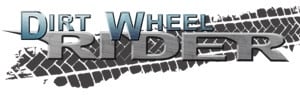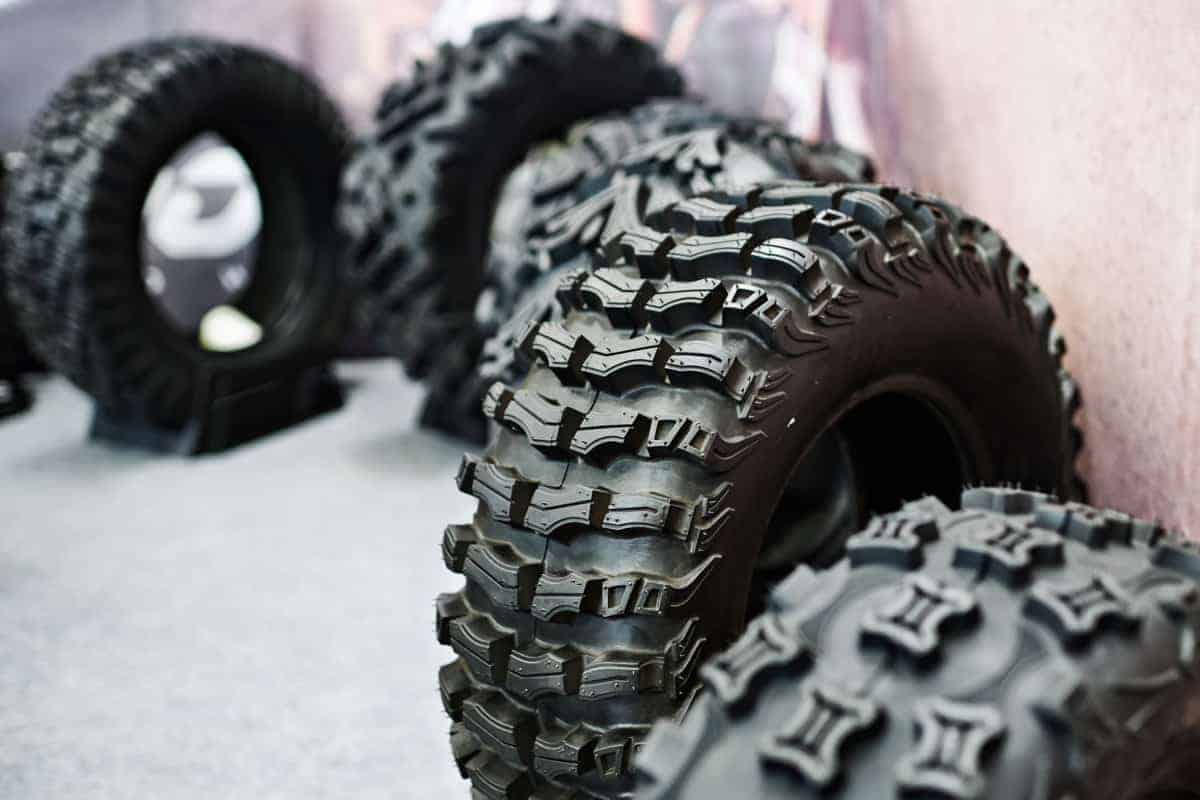Table of Contents
Ever seen an ATV? Yea, me too and I have always wondered why they had bigger tires in the back and smaller tires in the front. Well I looked around at powersport dealers and a lot when I was looking for an ATV and I also checked a lot of older quads and it turns out that almost ALL ATVS are configured this way. It baffled me the very first time I realized it but I certainly knew that they looked very cool if nothing else.
ATVs and UTVs have smaller tires in the front to increase handling, provide easier steering, and create better stability. Larger rear tires are there to increase traction and provide better acceleration.
There are many reasons why having smaller front tires and larger rear tires can be a big benefit but there are also some things to consider as well. On sport ATVs it is common to run this setup with about a 3 inch difference from front to rear and it is more common on utility 4WD ATVs to run the tires around 1 to 2 inches between front and rear. So let’s go ahead and discuss all the details so you can get the right tires for your ATV or UTV.
If you would like to take a look at the tires I recommend for ATVs and UTVs, take a look at my recommended tires page to see if the ones I picked are right for you.
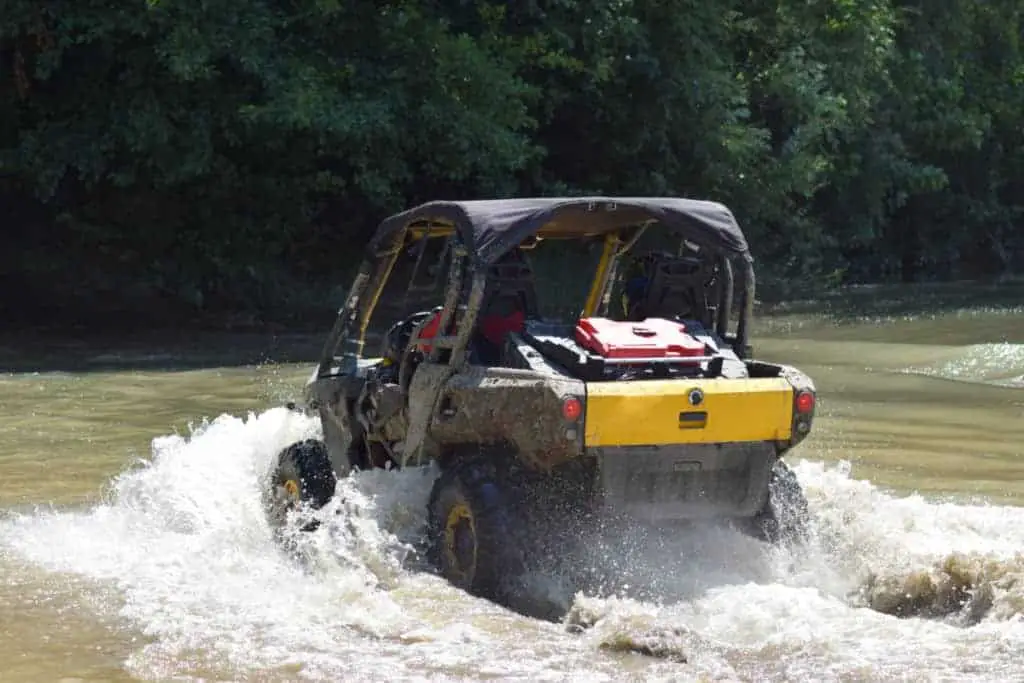
When referring to larger size tires in the front, I am not talking about tire diameter. Tire width is what provides several advantages when riding. It may seem like the front tires are smaller in diameter when looking at the two sets on your machine but that is more of an optical illusion.
Running Smaller Tires In The Front
Like I said, running smaller tires in the front definitely has its advantages and for sport ATVs the advantages significantly outweigh the disadvantages. Let’s talk about the pros of having smaller tires in the front.
The Pros:
Easier Steering With No Power Steering Equipped
If you have ever driven a car with power steering and then without power steering, you understand how hard it can be without assistance to actually get the wheels to turn. The same principle holds true with ATVs and UTVs as it does with the heavier vehicle. The difference between cars and trucks is that ATVs and UTVs utilize smaller front tires to alleviate this. Smaller tires in the front work because they have a much smaller surface area to come in contact with terrain meaning the driver has to exert LESS EFFORT to turn wheels with less ground contact.
The heavier the vehicle you are operating the more likely you will need power steering for a much easier time. I wrote an article about power steering and whether or not it is worth it right over here so if you want to get more information, go check it out.
This rule applies mostly to sport ATVs because they are not equipped with power steering. Sport ATVs are significantly lighter than 4WD Utility ATVs and UTVs so it takes even less effort than a vehicle twice its weight when trying to turn the handlebars. Engineers chose this combination of varying tire sizes after lots of testing and this was considered the best tire setup to ease the burden of steering during slow riding and while in reverse.
Better Overall Traction
Wider tires in the rear are common on almost all ATVs and UTV. Wider tires give the advantage of having more surface area for the tires to grip the terrain which provides more traction and control for the rider. This is especially useful when controlling the vehicle through turns. The more grip the rear tires maintain, the better a rider can control their ATV or UTV throughout the turn and maintain control when riding out. This is essential for racers as well as every day drivers or even weekend warriors.
Maintaining control throughout the turn also leads to better acceleration coming out of a turn which will increase overall speed when competing for every last millisecond in a race environment. Wider tires give you more grip on the terrain and allows the quad or UTV to “hook up” easier and accelerate sooner. Decreasing the overall diameter of the tire will make for greater acceleration but that is another subject.
Handling Increases
Handling is a big part of the steering but can be another category all together. Handling is how the ATV or UTV actually responds to what the rider inputs as well as how it moves along the track or the trail. Many factors can affect handling such as:
- Weight Distribution
- Center of Gravity
- Inertia
- Weight
- Aerodynamics
- Suspension Travel
- Power Delivered To The Vehicle
- Alignment
- And Frame Rigidity
As you can see, tire width isn’t the only thing that affects the handling but still plays its role in the whole process. The smaller front tires allow the driver inputs to be more responsive and add to the many factors that make a vehicle handle well.
They Just Look So Cool
Seeing an ATV, or a UTV, with smaller front tires actually is a very mean look, especially with sport ATVs and UTVs. Couple that with the already aggressive styling, when I see one come around a corner sliding and shoot out into the straight away it just reminds me of a drag car with those very large rear wheel and little front wheels. Something has always fascinated me about the way ATVs and UTVs look with the smaller tires.
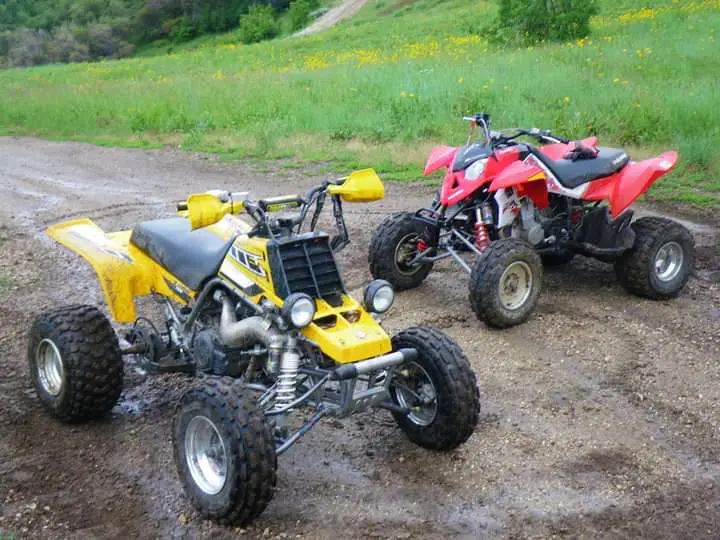
The Cons
Tire Heights Should All Be The Same
Most of the time it is the width that I am talking about when referring to smaller front tires but sometimes people like to put smaller diameter tires as well. This should be avoided in most cases because, in the case of most UTVs, it can make your speedometer readings incorrect by changing size in diameter.
Speedometers are calibrated from the factory to the stock tire size to make sure you get the most accurate reading possible. If you change tire heights, this can affect the accuracy of the reading and could cause you to get a ticket, especially if your UTV is street legal and on the road. I have a list of all 50 states where ATVs and UTVs are street legal right here if you want to make sure your ride can hit the streets legally.
Tire Rotations Are Much Harder
Typical tire rotations for all vehicles with the same width tire will have you remove the rear tires and move them to the front and take the front tires and move them to the rear. This poses a major problem because, as you know, the tires are different widths and for good reason.
If you put the smaller tires on the back you will lose out on ALL that extra grip and acceleration that the wider tires provide.
When you add to that the much larger tires in the front, you will have a much harder time steering and your handling will decrease dramatically. It will feel like the vehicle is much heavier than it really is and responsiveness will be significantly more sluggish.
Running 4 Tires Of The Same Size
Running tires that are the same size in width can be an option but if you ask me, the disadvantages are really not worth the effort of trying to attempt this. Some situations are better in a few situations and I will cover those below.
The Pros
Tire Rotations Become A Snap
With 4 tires having uneven widths, it was hard to be able to rotate your tires but with 4 same size tires, it becomes much easier. Since the tires would all be equal size, transferring a rear wheel to the front and a front wheel to the back will cause no issues. In fact, it is the proper way to rotate your tires.
Why Do We Rotate Tires?
Tire rotation is routinely performed so that all your tires are able to wear evenly. Making sure your tires wear evenly is an important part of prolonging the lifetime of a set of tires. It also keeps your tires even for more balanced handling.
For example, if you don’t rotate your tires and you happen to drive a front wheel car, the front wheels will lose tread more quickly than the rear over time. This can cause your handling to suffer.
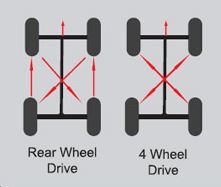
Easier To Carry Spare Tires
If you like to be prepared and carry a spare tire and wheel then the ability for you to be able to universally change any tire with just one spare setup is ideal to reduce weight and provide yourself more room. Many people like to prepare for any eventuality and pack everything down to extra tire setups to make sure they aren’t down for the count out on the trail.
If you run smaller tires in the front then you would have to carry a spare rear wheel setup AND a spare front tire setup just in case one or the other tire were to go flat or suffer any other damage.
DOT Tire Availability
If you want to make your ATV or UTV street legal then you want to make sure you get a set of DOT (Division of Transportation) approved tires to take with you on the road. Running tires the same size is preferential because it will keep your speedometer readings accurate and it will also help fuel efficiency.
DOT approved tires are more commonly stocked items because they are more in demand and makes them easier to find in the long run.
The Cons
Larger Front Tires Sling More Mud
If you install wider tires on an ATV or UTV that is designed for something with a smaller width, what do you think will happen? That’s right, the tires will be wider than the fairings on your vehicle and will sling up more mud and dirt up at you making your ride much more difficult in the long run.
Unless you can find some custom fairings, design some of your own wider fairings, or rig something up yourself, this will have an overall negative effect on the quality of your ride.
You May Have To Install Wheel Spacers
If you put wider tires on your ride, then expect there to be some issues with just popping some on and trying to go out for a ride. These vehicles are designed to take advantage of all the space they can and have narrow clearances as it is so installing a wider set of tires can cause them to rub up against inner fairings and even suspension parts. This can cause excessive wear on those parts and can also cause premature damage to the tires themselves.
To alleviate this, you may have to install wheel spacers to push them out far enough to prevent anything from rubbing. Wheel spacers push the wheels out even further than the wider tires do so make sure your clearance is good while driving straight and at extreme steering angles to the right and the left.
You Should Probably Have Power Steering Equipped
Wider tires have another issue that even deters me from trying it. Your steering will become much more difficult and make you exert more effort to turn the wheel or the handlebars. If you are riding a sport quad, there is really no room or need for power steering unless you add larger width front wheels. It is not even worth the effort to add power steering to something like that so if you are going to add larger wheels, add it to a vehicle that already comes equipped with power steering, or you can install a power steering unit yourself to help.
Need To Get Rims When Purchasing Tires
With some ATVs and UTVs you will be required to buy 2 new rims, or 4 depending on the tire size you want, in order to be able to run wider tires in the front. This can be financially draining especially if you don’t think about the other complications that can come from these new tires.
What Happens If You Increase Your Tire Size In Height?
Some people want to increase the size of their tires, but not in width. This provides several advantages and disadvantages depending on the application, so if you are thinking about getting larger diameter tires, it is best to consult a local professional so they can lay out exactly what needs to be done to YOUR machine.
Advantages
They Provide More Ground Clearance
Installing larger diameter tires will give you an immediate boost to your ground clearance depending on how large of tires you decide to get. This is especially good for 4WD utility ATVs and UTVs that do a lot or rock climbing or traversing a lot of terrain. Having more ground clearance will allow you to climb over higher obstacles and prevent the underside of your ride from catching on more things that might cause damage or get you stuck, and getting stuck is one of the last things we want out on the trails.
They Can Provide Your Ride With Some Aggressive Looks
Larger diameter tires look pretty freaking sweet, especially if you put the ones with aggressive mudding or aggressive track tread on them. You get to sit much higher and look down on those smaller tire drivers with your nose up in the air. But really, installing the right tires on your ride can make all the difference when people see you roll by so make sure they aren’t a good match.
Traction Is King In The Off Roading World
Traction is a huge deal when it comes to riding ATVs and UTVs and larger diameter tires also provide you with plenty of that. Just like wider tires, larger diameter tires have more of the tire touching the ground at one time which inherently increases traction.
Sport ATV Racing
Racers will run larger diameter front tires a lot of the time because it helps them when they are riding on certain type of tracks. Many people call this the “nose up” configuration because it makes the nose sit slightly higher than the rear.
The reason they do this is actually pretty cool and I didn’t understand why for a long time. Once I got more into sport quad racing I learned that they did this to keep the nose from bogging down in the whoop sections of the race track. The fastest way to get through the whoops is to enter very fast and skip over the tips of the hills with the rear wheels. Have a nose up configuration can make it easier to get the nose end up.
The whoop section is where it helps the most as it will allow the front end to not bottom out in the valley of the whoop if you happen to get yourself out of rhythm. It will reduce the amount that you are slowed down tremendously to skip along the tops though.This type of setup will also enable the quad to handle these riding conditions much more efficiently and will pose less risk of flipping over if you don’t land just right.
Disadvantages
It is a general rule of thumb that you can 1, maybe even 2 sizes larger than the stock tire size before you start to notice any of the disadvantages listed below. In order to reduce or eliminate these disadvantages, you will need to install modifications accordingly to reduce the stresses caused by going too much larger on your tires.
Larger Tires Hard To Find
If you are thinking about running larger diameter tires, you have to consider the availability of tires. Sometimes, if you are looking for just the right tire, the availability may be low and if you happen to get a set, will they continue to make those tires due to low demand? These are some considerations to take before going out and getting large diameter aggressive tire styles. I try to stick with brands and sizes that are very popular to reduce the risk of having to change my entire setup should I not be able to find the same tire sizes I had installed on my ride.
Loss of Low End Torque
As you increase your tire size, you are also increasing the weight. Now is the weight all that noticeable when it comes to performance, probably not, but more diameter on the tire AND more weight means the ATV or UTV has to do more work to get the wheel to turn one revolution. This will negatively affect the acceleration you see at low gearing and RPMs and may hinder the ability to power your ride out if you get stuck…unless you add some more power to your vehicle. I wrote a couple of articles about mudding modifications for utility ATVs and modifications for sport ATVs if you want to check either one out to get and idea what you may need.
Increased Clutch Wear
The added tire weight and larger diameter of tires will make your vehicle have a higher gear ratio and will hinder your ability to spin the wheels the way your ride needs in mud or other terrain to be able to get free.
Reducing the gear ratio by adding a new clutch kit will allow the wheels to spin faster. This will allow the engine to rev higher before engaging the clutch and will give you the power when you need it the most. You will lose more top end speed with this type of tire setup so if you want to be able to go faster, a clutch kit might not be the correct choice.
Tire Rub on Body Panels / Suspension Components
I discussed this before with wider tires and the same holds true here. Your vehicle was designed for a certain size tire and you may introduce unnecessary wear and tear on your suspension and your inner fairings and body components.
Increased Drive Belt Wear
If not properly attended to, larger tires will put much more strain on your drive belt causing it to wear much faster and possibly break sooner than it normally would.
Premature Drive Train Failure
The stock drive train components aren’t made to hold up to the extra stress that heavier tires put on them. This stress will speed up the wear and tear on these components and likely lead to premature failure when compared to an upgraded setup. To avoid this, you may want to consider installing heavy drive train components.
Premature Axle Failure
Due to extreme angles that can be introduced into the system by installing larger diameter tires, you can cause premature axle failure as well if you don’t upgrade to a stronger and more functional system.
Premature Wheel Bearing Failure
Your wheel bearings are meant to take the load of stock tire sizes and all that extra weight can cause the bearings to go out early as well.
Increased Roll-Over Rate
Your center of gravity will also be affected by this change and will make your ride height affect rollover rate and handling. With a higher center of gravity it will be much easier to cut a turn a little too sharp and end up rolling over and hurting yourself or damaging your ride.
The Takeaway
If you have read all of the reasons above and you still want to install larger diameter or larger width ATV or UTV tires, please contact your local dealer or powersports mechanic shop and and make sure everything that you do, you consult an expert with because I would hate to see someone damage their vehicles unnecessarily because they just didn’t want to do the research necessary to ensure their ride is top notch before taking it out.
